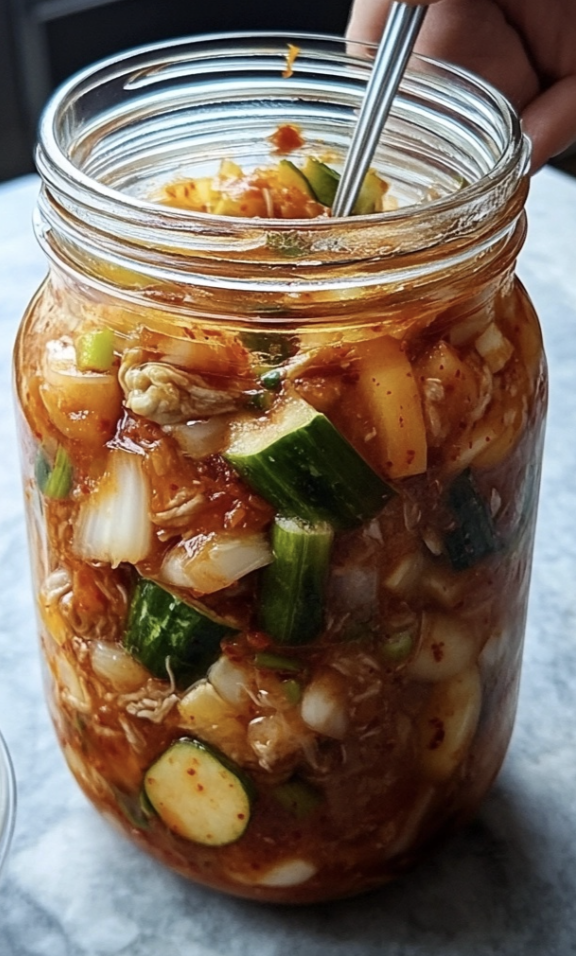Jean’s Kimchi Recipe
Introduction
Kimchi is a traditional Korean dish that has gained popularity all over the world for its unique flavors and health benefits. This fermented cabbage dish is not only delicious but also packed with probiotics, vitamins, and minerals. In this article, we will share Jean’s secret kimchi recipe that has been passed down through generations. Follow these steps to create your own homemade kimchi that will impress your family and friends.
Ingredients
Main Ingredients:
- 1 large head of Napa cabbage
- 1/4 cup sea salt
- 1 tablespoon grated ginger
- 4 cloves of garlic, minced
- 2 tablespoons Korean red pepper flakes (Gochugaru)
- 2 teaspoons sugar
- 4 green onions, chopped
- 1 medium-sized carrot, julienned
Optional Ingredients:
- 1 small daikon radish, julienned
- 1/2 cup Korean fish sauce
- 1 tablespoon shrimp paste
- 1 tablespoon soy sauce
- 1 tablespoon sesame oil
- 1 tablespoon rice vinegar
- 1 teaspoon honey
Steps
- Cut the Napa cabbage in half lengthwise and remove the core. Then, cut the cabbage into 2-inch squares.
- In a large bowl, dissolve the sea salt in water. Soak the cabbage in the saltwater for about 2 hours, turning occasionally.
- While the cabbage is soaking, prepare the seasoning paste. In a separate bowl, mix the grated ginger, minced garlic, Korean red pepper flakes, and sugar.
- After 2 hours, rinse the cabbage under cold water to remove excess salt. Squeeze out any excess water and set aside.
- In a large mixing bowl, combine the cabbage, seasoning paste, green onions, and carrot. Toss well to ensure the cabbage is evenly coated with the paste.
- If using any optional ingredients, add them at this stage and mix well.
- Transfer the kimchi into a clean glass jar, pressing down firmly to remove any air bubbles. Leave about 1 inch of space at the top of the jar.
- Seal the jar tightly and leave it at room temperature for 24-48 hours to allow the fermentation process to take place. Check the kimchi daily and press it down to release any built-up gases.
- After the fermentation period, transfer the jar to the refrigerator to slow down the fermentation process. The kimchi will be ready to eat after a few days, but it will continue to develop flavor over time.
Variations
While Jean’s kimchi recipe is delicious on its own, you can customize it to suit your taste preferences. Here are some variations you can try:
- Add fruits like apples or pears for a slightly sweet and tangy flavor.
- Include different vegetables like radishes, cucumbers, or onions for added crunch.
- If you prefer a milder kimchi, reduce the amount of Korean red pepper flakes.
- Experiment with different seasonings like miso paste, curry powder, or chili paste.
Tips
- Use fresh and high-quality ingredients for the best flavor.
- Wear gloves while handling the Korean red pepper flakes to avoid skin irritation.
- Make sure to press down the kimchi in the jar during fermentation to release any gases.
- Allow the kimchi to ferment for at least 24 hours, but longer fermentation will result in more intense flavors.
- Store the kimchi in the refrigerator to slow down fermentation and prolong its shelf life.
Conclusion
With Jean’s kimchi recipe, you can now enjoy the delicious and probiotic-packed flavors of this traditional Korean dish in the comfort of your own home. Whether you follow the recipe as is or customize it to suit your taste, homemade kimchi is a versatile and nutritious addition to any meal. So gather your ingredients, follow the steps, and start fermenting your way to a flavorful and healthy kimchi experience.
FAQs
1. How long does homemade kimchi last?
Properly stored homemade kimchi can last for several months in the refrigerator. As it ages, the flavors will continue to develop and the kimchi may become more sour.
2. Can I adjust the spice level of the kimchi?
Absolutely! You can adjust the amount of Korean red pepper flakes according to your spice tolerance. Start with a smaller amount and add more if desired.
3. Can I use regular cabbage instead of Napa cabbage?
While Napa cabbage is traditionally used for kimchi, you can experiment with regular cabbage or even other leafy greens. Keep in mind that the texture and flavor may vary.
4. Can I eat kimchi if I’m vegetarian or vegan?
Yes, you can omit any seafood-based ingredients and still enjoy delicious vegetarian or vegan kimchi. The flavors will still be vibrant and the fermentation process will create the signature tanginess.
5. Can I reuse the kimchi juice for other recipes?
Yes, the kimchi juice can be used as a flavorful base for soups, stews, or dressings. It adds a tangy and umami-rich flavor to your dishes.
Now that you have all the information you need, it’s time to gather your ingredients and start making your own batch of Jean’s kimchi. Enjoy the process of fermenting and savor the delicious flavors of this traditional Korean delicacy!







Hi there just wanted to give you a brief heads up and let you know a few of the images aren’t loading correctly. I’m not sure why but I think its a linking issue. I’ve tried it in two different web browsers and both show the same results.
I’m still learning from you, but I’m making my way to the top as well. I definitely love reading everything that is posted on your website.Keep the aarticles coming. I enjoyed it!
I just could not depart your website before suggesting that I extremely enjoyed the standard information a person provide for your visitors? Is gonna be back often in order to check up on new posts
Hey there! Someone in my Myspace group shared this site with us so I came to take a look. I’m definitely loving the information. I’m book-marking and will be tweeting this to my followers! Wonderful blog and outstanding design.
Woah! I’m really digging the template/theme of this blog. It’s simple, yet effective. A lot of times it’s challenging to get that “perfect balance” between user friendliness and appearance. I must say you’ve done a very good job with this. Additionally, the blog loads super fast for me on Internet explorer. Excellent Blog!
Good day! This is my 1st comment here so I just wanted to give a quick shout out and tell you I genuinely enjoy reading through your posts. Can you recommend any other blogs/websites/forums that cover the same topics? Thanks a ton!
Thank you for your post. I really enjoyed reading it, especially because it addressed my issue. http://www.hairstylesvip.com It helped me a lot and I hope it will also help others.
I’m so in love with this. You did a great job!! http://www.hairstylesvip.com
Thanks for sharing. I read many of your blog posts, cool, your blog is very good.
Thank you for your sharing. I am worried that I lack creative ideas. It is your article that makes me full of hope. Thank you. But, I have a question, can you help me?
Thanks for sharing. I read many of your blog posts, cool, your blog is very good. https://www.gate.io/share/XwNAUwgM